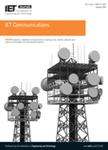版权所有:内蒙古大学图书馆 技术提供:维普资讯• 智图
内蒙古自治区呼和浩特市赛罕区大学西街235号 邮编: 010021

作者机构:Natl Univ Def Technol Coll Comp 109 Deya Rd Changsha Peoples R China Natl Univ Def Technol State Key Lab Complex Electronmagnet Environm Eff 109 Deya Rd Changsha Peoples R China Changsha Univ Coll Comp Engn & Appl Math 98 Hongshan Rd Changsha Peoples R China
出 版 物:《IET COMMUNICATIONS》 (IET通信)
年 卷 期:2020年第14卷第22期
页 面:4081-4088页
核心收录:
基 金:fund of Science Project of Hunan Province [2018XK2102] 31513010602-1
主 题:feature extraction learning (artificial intelligence) signal classification higher order statistics Newton method conjugate gradient methods optimisation modulation neural nets optimising SAE model data normalisation methods unconstrained optimisation theory recognition accuracy SNR practical AMC model noise environments automatic modulation classification AI technology stacked auto‐ encoder feature space high‐ order cumulants linear normalisation signal‐ to‐ noise ratio Nelder‐ Mead method Newton optimisation method conjugate gradient method quasiNewton method optimisation method structure intelligently process spectral‐ based features
摘 要:Automatic modulation classification (AMC) has recently attracted widespread attention nowadays due to its desirable features of generalisability and requirement of little prior knowledge through artificial intelligence (AI) technology. The authors propose a stacked auto-encoder (SAE) based on various optimisation methods structure to intelligently process a feature space that includes spectral-based features and high-order cumulants. To unify the dimensionality of the features, they apply different normalisation methods to the feature space before training the SAE model to decide corresponding normalisations under different noise environments. Linear normalisation is superior when signal-to-noise ratio (SNR) is low, and standardisation is superior when SNR is between -1 and 4 dB. Regularisation works best when SNR is greater than 5 dB. To increase the recognition accuracy of the proposed model, they introduce the unconstrained optimisation theory to adjust the proposed SAE model, including Nelder-Mead method, Newton optimisation method, conjugate gradient method and quasi-Newton method. They observe that the quasi-Newton method offers desirable performance when optimising SAE model. It is the first time to compare these data normalisation methods and discuss unconstrained optimisation theory together to recognise modulation types. The recognition accuracy of this model for eight modulation types can reach 99.8% when SNR ranges from -5 to 10 dB.